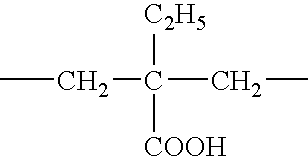Electromagnetic wave shield with vacuum deposited metal using water dispersed polyurethane
- Summary
- Abstract
- Description
- Claims
- Application Information
AI Technical Summary
Benefits of technology
Problems solved by technology
Method used
Image
Examples
examples 1 to 6
[0040]Preparation of a Polyurethane Prepolymer
[0041]A cooling apparatus, a thermometer, a stirrer and a mantle were prepared in 1 L cleaned 4-neck flask, and 406 g of polytetramethylether glycol (PTMEG) (MW: 2000), 105 g of Placcel 205BA (MW: 500), 0.5 g of dibutyltin dilauriate (DBTDL), 130 g of n-methyl pyrollidone (NMP) and 153 g of 4,4′-dicyclohexylmethane diisocyanate were poured into the flask, and reacted for 4 hours to provide a polyurethane prepolymer.
[0042]While 420 g of ion exchanged water, 12.3 g of triethylamine and 50 g of isopropyl alcohol were mixed in a separate 2 L beaker and agitated vigorously, 350 g of the polyurethane prepolymer prepared as above were poured slowly to solubilize in water. After vigorous agitation and solubilization in water for about 30 minutes, 80 g of ion exchanged water and 1.7 g of ethylene diamine were mixed and poured slowly, and after pouring and then vigorous agitation for about 20 minutes, the temperature was elevated to 70° C., and sl...
example 7
[0054]Cleaned 4 L flask, a stirrer, a mantle, a cooling tube and moisture separator were equipped, 229 g of ethylene glycol, 136 g of neopentyl glycol, 365 g of 1,6-hexanediol, 413 g of isophthalic acid, 363 g of adipic acid and 234 g of azellic acid were poured and 0.3 g of TBT (tributyltin) were poured, and when the temperature was elevated to around 130° C., melting and dehydration are slowly initiated. Then nitrogen is slowly added, and the temperature is continuously elevated to 250° C., and while maintaining 250° C., reaction is performed until acid value reaches below 0.1. After reaction is completed, a transparent polyester diol having average molecular weight of 3600 and acid value below 0.1 was prepared.
[0055]A stirrer, a mantle and a cooling tube were equipped in separate 1 L flask, 350 g of diol (molecular weight of 3600) prepared as above, 249 g of normal methyl pyrollidone and 39 g of dimethylol propionic acid were poured and stirred, and 208 g of isophorone diisocyana...
example 8
[0057]170 g of ethylene glycol, 570 g of neopentyl glycol, 208 g of terephthalic acid, 138 g of isophthalic acid and 611 g of adipic acid were poured and 0.3 g of TBT (tributyltin) were poured, and when the temperature was elevated to around 130° C., melting and dehydration are slowly initiated. Then nitrogen is slowly added, and the temperature is continuously elevated to 250° C., and while maintaining 250° C., reaction is performed until acid value reaches below 0.1. After reaction is completed, a transparent polyester diol having average molecular weight of 1950 and acid value below 0.1 was prepared.
[0058]A stirrer, a mantle and a cooling tube were equipped in separate 1 L flask, 110 g of diol (molecular weight of 1950) prepared as above, 42 g of acrylpolyol (molecular weight of 1000) UMM-1001 (Japan Soko Chemistry), 37 g of dimethyl propionic acid and 210 g of normal methyl pyrollidone were poured and stirred, and 208 g of isophorone diisocyanate and again 0.1 g of dibutyltin di...
PUM
| Property | Measurement | Unit |
|---|---|---|
| Percent by mass | aaaaa | aaaaa |
| Percent by mass | aaaaa | aaaaa |
| Percent by mass | aaaaa | aaaaa |
Abstract
Description
Claims
Application Information
 Login to View More
Login to View More - R&D
- Intellectual Property
- Life Sciences
- Materials
- Tech Scout
- Unparalleled Data Quality
- Higher Quality Content
- 60% Fewer Hallucinations
Browse by: Latest US Patents, China's latest patents, Technical Efficacy Thesaurus, Application Domain, Technology Topic, Popular Technical Reports.
© 2025 PatSnap. All rights reserved.Legal|Privacy policy|Modern Slavery Act Transparency Statement|Sitemap|About US| Contact US: help@patsnap.com


